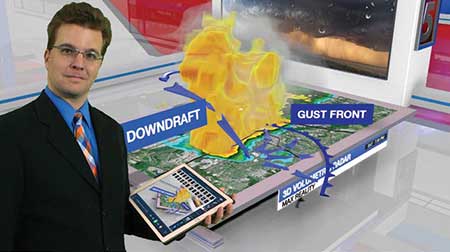A Clearer Forecast for Weather Graphics
LOS ANGELES—The weather report is a linchpin of local broadcasting, and weather graphics play an important role in allowing broadcasters to stay fresh, attract viewers and keep them coming back. TV Technology spoke with four major providers of weather graphics—AccuWeather, ChyronHego and Vizrt, and The Weather Company—to find out what broadcasters are asking for and what trends are coming to the fore.
WHITHER 4K?

Bill Boss, accuWeather’s director of product development In 2014, The Weather Channel announced “ambitious plans to fully convert to 4K content acquisition, production and distribution by 2018.” Two years later, The Weather Company and other providers are still waiting for broadcasters to ask for 4K. “Our solution can support 4K,” says Bill Dow, senior vice president/general manager of media for The Weather Company, an IBM subsidiary and provider of weather graphics based in Andover, Mass. “But we haven’t been hearing that our customers are ready to jump to 4K. It’s a large expense for their infrastructure.”
ChyronHego Metacast sales director Karl Eggestad echoes Dow’s assessment, noting that, although Metacast is 4K-ready, nobody in the U.S. is asking for it yet. He and Bill Boss, AccuWeather’s director of product development, display systems and services, believe that 4K weather graphics will come to the fore over the next 18 months.
Eduardo Mancz, vice president of operations for Vizrt Americas, agrees that the lack of 4K infrastructure is what’s hampering the transition, although he does note that the company has a handful of customers doing 4K trials. “There is a limitation and complication at the physical layer,” Mancz said. “4K is a proven technology [but] the challenge for broadcasters is to carry all the infrastructure for 4K, and the solution is IP.”
AR COMES INTO FOCUS

The Weather company recently debuted a new iPad application for Max connect. Similar to 4K, most broadcasters aren’t quite ready to embrace augmented reality, but some weather graphics providers want to be there when the time is right. “Our Max Reality product launched with augmented reality capability in 2015,” says Dow. “Now we’ve expanded it to a complete virtual set that can really grab younger viewers by creating the high-end, rich visualization they’re used to.” Although Dow can’t go public with their names, several customers are using the initial version of Max Reality’s AR component, he says.
“As is normal with new technology, the station groups are being cautious about how they adopt it,” he adds, explaining the slow adoption. “They want to make sure they understand how to use it and the value behind it.” To make it easier, Max Reality’s virtual set capability is integrated with a station’s everyday workflow, something that the old generation of virtual sets didn’t offer. “Now the entire weather presentation can be a virtual set plus AR,” Dow said.
Vizrt Americas has an augmented reality project in California that will be made public in a few weeks, according to Mancz. He points out that whether or not to use AR is, “ultimately more of an editorial than a technical decision.” Eggestad says ChyronHego offers augmented reality through its partner HybridTV.com. “We are getting requests for it,” he said. “In a few months we’ll be able to offer AR through Metacast. It’s a matter of finding display methods that make sense with weather.” Boss says AccuWeather also has a path towards AR. “The two hurdles are that it’s expensive and hard to understand how to use every day,” he said. “We want to make sure anything we do here is easy for the user and something they can use every day.”
IMPROVING WORKFLOWS
ChyronHego has enhanced weather graphics workflow by integrating the weather desk with the rest of the news operation. “Metacast is now part of the ChyronHego CAMIO universe,” Eggestad says. “Metacast sits as an intelligent device on this massive CAMIO infrastructure, which means it can be operated not just by the meteorologist but also by the journalists, editors, producers and control operators. And it can be called up from any device in the universe. That all creates huge efficiencies.”
AccuWeather’s new StormDirector Plus weather graphics system works on a touchscreen, greenscreen or videowall, giving broadcasters more flexibility, according to Boss. “This helps the broadcaster be interactive and get hyper-local,” he said. StormDirector also integrates with social media. “Whether the station pushes it out or gets information in, they can put it in the air,” Boss said. “It engages the viewers to get their content on the air.”
Vizrt just released Vizrt Weather Alerts, a one-box solution similar to its flagship Viz Weather. “This solution combines the graphics, maps and social media that allows the station to access free or paid data sources,” Mancz said. “We’re taking advantage of powerful technology to do something smaller, specifically for alerts.” The Weather Company’s new iPad application for Max Connect “lets the presenter control the show in a very intuitive way and continue to face the audience during the entire presentation,” said Dow.
Not quite ready for 4K and augmented reality, broadcast stations want integrated, flexible solutions, and that’s what weather graphics companies are giving them.
Get the TV Tech Newsletter
The professional video industry's #1 source for news, trends and product and tech information. Sign up below.
